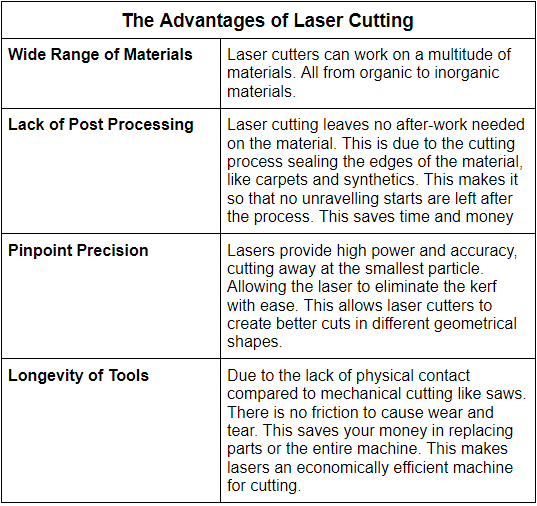What is laser cutting?
Laser cutting is a commonly used process in the world for cutting a wide variety of materials. Lasers have high accuracy, speed and versatility putting them at a large advantage over other cutting methods.

How does laser cutting work?
Laser cutting utilises electrical energy to create a high heat intensity laser. Thus, laser cutting is a type of thermal separation technique. The laser hits the surface of the material, making it heat up until it melts or completely evaporates. Once the laser has passed through the material at the starting point, the actual cutting process will begin. The laser system will follow a predetermined path, based on the design that the machine has received.
How does a Laser Cutting Machine Work?
A laser cutting machine includes the lasers power source with some shutter control, a beam guidance train, focusing optics and a means of moving the beam or workpiece relative to each other. When the beam is required, the shutter mirror is rapidly removed by a solenoid or pneumatic piston. And the beam generated with the laser power source passes to the beam guidance which directs the beam to the focusing optic. The focusing optic can be either transmissive or reflective. The reflective optics consists of parabolic off-axis mirrors. The focused beam then passes through and melts the material throughout the material thickness and a pressurized gas jet. The gas jet is needed both to aid the cutting operation and to protect the optic from spatter.

Different Laser Cutting Methods
There are multiple different ways a laser cutting machine can carry out the process. Different techniques are required for different materials. As each material can have different reaction to the environment and the laser as well as vary in melting point.
These 3 different methods are:
Laser fusion cutting
The laser fusion process utilizes the laser beam to heat up the material till it begins to melt. While the cutting process is happing, an inert gas such as nitrogen is used to blow away the melted material. The inert gas also helps protect the heated material from the surrounding air as well as protecting the laser optics. Laser fusion cutting is mainly used for metallic material this is also includes high alloyed steels like stainless steel, aluminum, and titanium alloys. The advantage of this process is that the cut edge is free of oxides with a high-quality result.

Laser oxygen cutting
In laser oxygen cutting the laser beam heats the material in an oxidizing atmosphere into the melting point of the material. Therefore, an additional source of energy is obtained from the exothermic oxidation reaction of the oxygen with the material. And the molten material is rapidly removed away by the assist gas. The laser oxygen cutting is mainly used for steel and low-alloyed steel.


Laser vaporization cutting
In the process of laser vaporization cutting, the material is heated beyond its melting temperature and eventually evaporated. During this process, a keyhole is generated in the evaporated position. The keyhole causes a sudden increase in the absorptivity, because of the multiple reflections. This results in the rapid deepening of the keyhole. Thus, causing vapor to generate and escapes. The process gas can help the material removal. The energy requirements of this process depend upon the thermal properties of the base material, which are usually quite high. This is because the method is usually used to cut materials which do no melt such as wood, carbon, and some plastic.

Laser Cutting Parameters
The process of laser cutting involved many parameters, which can be generally divided into two main categories—beam parameters and process parameters.
Beam parameters
These are the parameters that characterize the properties of the laser beam which include the wavelength, power, intensity, and spot size, continue wave and pulsed power, beam polarization, beam mode and quality.
Process parameters
These are the parameters that characterize the properties of the laser beam which include focusing of laser beams, focal position and dual focus lens, process gas and pressure, nozzle diameter, stand-off distance and alignment, and cutting speed.
